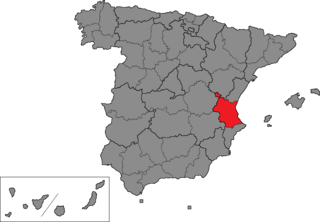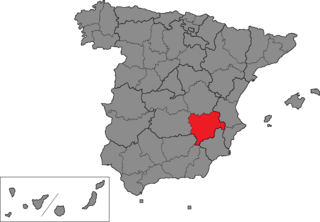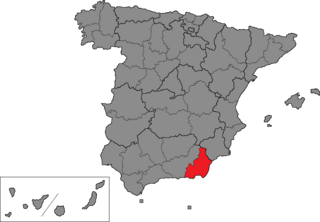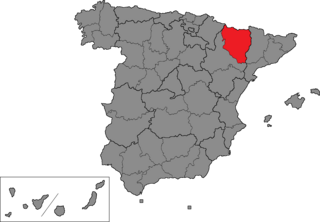
Valencia is one of the 52 constituencies represented in the Congress of Deputies, the lower chamber of the Spanish parliament, the Cortes Generales. The constituency currently elects 16 deputies. Its boundaries correspond to those of the Spanish province of Valencia. The electoral system uses the D'Hondt method and a closed-list proportional representation, with a minimum threshold of 3 percent.

Madrid is one of the 52 constituencies represented in the Congress of Deputies, the lower chamber of the Spanish parliament, the Cortes Generales. The constituency currently elects 36 deputies. Its boundaries correspond to those of the Spanish province of Madrid. The electoral system uses the D'Hondt method and a closed-list proportional representation, with a minimum threshold of 3 percent.

Asturias—Oviedo until 1986—is one of the 52 constituencies represented in the Congress of Deputies, the lower chamber of the Spanish parliament, the Cortes Generales. The constituency currently elects eight deputies. Its boundaries correspond to those of the Spanish province of Asturias. The electoral system uses the D'Hondt method and a closed-list proportional representation, with a minimum threshold of 3 percent.

Biscay is one of the 52 constituencies represented in the Congress of Deputies, the lower chamber of the Spanish parliament, the Cortes Generales. The constituency currently elects eight deputies. Its boundaries correspond to those of the Spanish province of Biscay. The electoral system uses the D'Hondt method and a closed-list proportional representation, with a minimum threshold of 3 percent.

Barcelona is one of the 52 constituencies represented in the Congress of Deputies, the lower chamber of the Spanish parliament, the Cortes Generales. The constituency currently elects 31 deputies. Its boundaries correspond to those of the Spanish province of Barcelona. The electoral system uses the D'Hondt method and a closed-list proportional representation, with a minimum threshold of 3 percent.

Ceuta is one of the 52 constituencies represented in the Congress of Deputies, the lower chamber of the Spanish parliament, the Cortes Generales. The constituency currently elects one deputy using plurality voting. Its boundaries correspond to those of the autonomous city of Ceuta.

Álava is one of the 52 constituencies represented in the Congress of Deputies, the lower chamber of the Spanish parliament, the Cortes Generales. The constituency currently elects four deputies. Its boundaries correspond to those of the Spanish province of Álava. The electoral system uses the D'Hondt method and a closed-list proportional representation, with a minimum threshold of 3 percent.

Gipuzkoa is one of the 52 constituencies represented in the Congress of Deputies, the lower chamber of the Spanish parliament, the Cortes Generales. The constituency currently elects six deputies. Its boundaries correspond to those of the Spanish province of Gipuzkoa. The electoral system uses the D'Hondt method and a closed-list proportional representation, with a minimum threshold of 3 percent.

Albacete is one of the 52 constituencies represented in the Congress of Deputies, the lower chamber of the Spanish parliament, the Cortes Generales. The constituency currently elects four deputies. Its boundaries correspond to those of the Spanish province of Albacete. The electoral system uses the D'Hondt method and a closed-list proportional representation, with a minimum threshold of 3 percent.

Girona is one of the 52 constituencies represented in the Congress of Deputies, the lower chamber of the Spanish parliament, the Cortes Generales. The constituency currently elects six deputies. Its boundaries correspond to those of the Spanish province of Girona. The electoral system uses the D'Hondt method and a closed-list proportional representation, with a minimum threshold of 3 percent.

Almería is one of the 52 constituencies represented in the Congress of Deputies, the lower chamber of the Spanish parliament, the Cortes Generales. The constituency currently elects six deputies. Its boundaries correspond to those of the Spanish province of Almería. The electoral system uses the D'Hondt method and a closed-list proportional representation, with a minimum threshold of 3 percent.

Guadalajara is one of the 52 constituencies represented in the Congress of Deputies, the lower chamber of the Spanish parliament, the Cortes Generales. The constituency currently elects three deputies. Its boundaries correspond to those of the Spanish province of Guadalajara. The electoral system uses the D'Hondt method and a closed-list proportional representation, with a minimum threshold of 3 percent.

Cuenca is one of the 52 constituencies represented in the Congress of Deputies, the lower chamber of the Spanish parliament, the Cortes Generales. The constituency currently elects three deputies. Its boundaries correspond to those of the Spanish province of Cuenca. The electoral system uses the D'Hondt method and a closed-list proportional representation, with a minimum threshold of 3 percent.

Huesca is one of the 52 constituencies represented in the Congress of Deputies, the lower chamber of the Spanish parliament, the Cortes Generales. The constituency currently elects three deputies. Its boundaries correspond to those of the Spanish province of Huesca. The electoral system uses the D'Hondt method and a closed-list proportional representation, with a minimum threshold of 3 percent.

This is the results breakdown of the Congress of Deputies election held in Spain on 9 March 2008. The following tables show detailed results in each of the country's 17 autonomous communities and in the autonomous cities of Ceuta and Melilla, as well as a summary of constituency results.

This is the results breakdown of the European Parliament election held in Spain on 7 June 2009. The following tables show detailed results in each of the country's 17 autonomous communities and in the autonomous cities of Ceuta and Melilla.

This is the results breakdown of the European Parliament election held in Spain on 10 June 1987. The following tables show detailed results in each of the country's 17 autonomous communities and in the autonomous cities of Ceuta and Melilla.

This is the results breakdown of the European Parliament election held in Spain on 15 June 1989. The following tables show detailed results in each of the country's 17 autonomous communities and in the autonomous cities of Ceuta and Melilla.

This is the results breakdown of the European Parliament election held in Spain on 12 June 1994. The following tables show detailed results in each of the country's 17 autonomous communities and in the autonomous cities of Ceuta and Melilla.

This is the results breakdown of the European Parliament election held in Spain on 13 June 2004. The following tables show detailed results in each of the country's 17 autonomous communities and in the autonomous cities of Ceuta and Melilla.























